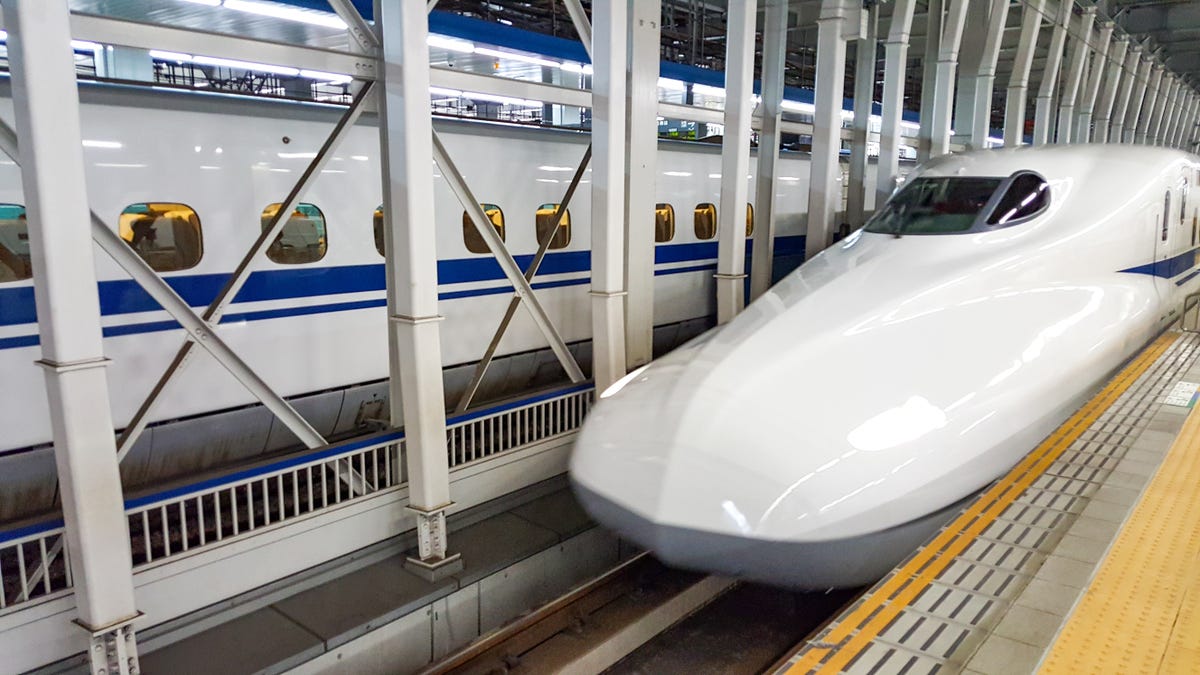See trains from all over the world
From high-speed electrics to workhorse diesel-electrics, here's a selection of trains from other countries.

Trains of the world
Though high speed trains are amazing, they're not as common as you might think. The follow is a smattering of pictures of trains from around the world, starting with this N700 Series shinkansen pulling in to Hakata station.
Hokkaido
The loooong nose of a Hitachi E5 Series, waiting at Shin-Hakodate-Hokuto station on the island of Hokkaido. These are among the fastest shinkansen trains, with a top speed of 320 km/h (200 mph), less when going through the Seikan Tunnel.
EMU
A Hitachi 885 Series electric multiple unit in Nagasaki at the beginning of my 8-hour adventure across Japan by train.
Kyoto Railway Museum
The Kyoto Railway Museum has a ton of amazing historical Japanese trains, which is why we checked it out thoroughly.
TGV
After Japan, France is probably what comes to mind when you think "high speed trains." This is an Alstom TGV Duplex Dasye with top speeds of 320 km/h (200 mph) and is less than 10 years old.
Bi-level, bi-continent
An Alstom Avelia Euroduplex, here in SNCF livery. A version of this train has been built and is entering service in Africa's first high-speed rail line, between Casablanca and Tangier.
Channel tunnel sprint
A British Rail Class 374, aka the Eurostar e320, built by Siemens. This new train is one of the ones I rode on my epic adventure to cross three countries in 14 hours on four trains and a bus.
Flying Scotsman
An electric InterCity 225 still wearing the recently defunct Virgin Trains East Coast livery. The locomotives from these trains date from the late 1980's.
Highlander
An Alstom-built British Rail Class 67 diesel-electric locomotive, seen here pulling the Caledonian Sleeper overnight train in Inverness, Scotland. It was built in 2000 and is named "Schenker."
Rápido
Two trains in Spain's plains. Spain has an extensive high-speed rail network. On the left is the AVE Class 102, aka the Talgo 350. Top operating speed is 330 km/h (205 mph). On the right is the older Class 100, by Alstom.
Nice fjords
The NSB El 17 electric locomotive were quite unreliable to start, but the second batch has held up well, even on Norway's grueling Flåm Railway as seen here. From my Instagram.
Velaro D
Velaro D high-speed trains at Siemens testing center in Wegberg-Wildenrath. These have a max speed of 320 km/h (200 mph) and are closely related to the Eurostar trains you saw a few slides ago.
Hands on the wheel, buddy
Inside a Velaro D at speed.
Grüß gott!
A Bombardier Talent, which is available as a DMU or EMU, seen here in Österreichische Bundesbahnen (Austrian Federal Railways) livery at Vienna Central Station.
Night service
Many regions use older trains for night services. This is a multisystem ČD Class 362 built in the late 80's and in service with ZSSK in Slovakia.
Thailand
An Alstom, then Alsthom, AD24C. This is an extremely common diesel-electric locomotive in Thailand, with over 100 in service built throughout the 80's.
GE
A GE CM22-7i, or GEA, built in 1995 for the State Railway of Thailand. This is a good example of why it's hard to judge a locomotive's age by its looks. Top speed is 100 km/h (62 mph).
Charger!
One of the new Siemens diesel-electric Chargers rolling out now (pun intended) on the Pacific Surfliner route in Southern California and other routes around the country. We had a look in and around this locomotive's unveiling which you can read about in Charger into the future.
Electro-motive
One of the 20-year-old EMD F59PHIs being replaced by the Chargers. The were sold to Metra in Chicago and will continue their service there.
America's high speed train
The Acela Express currently uses trainsets built by Bombardier and Alstom. They're significantly heavier than other high-speed trains due to unique crash standards, though these are due to be reduced.
Next-gen
The Acela Express will get new electric trains in 2021 built by Alstom called Avelia Liberty. They have numerous improvements over the aging Acela trains, including being a bit faster, though the Acela's speed was always limited by the tracks, not the train.
VHS
The Bombardier Zefrio 380, one of the fastest trains in the world, cruises across China at 380 km/h (236 mph).
Molto veloce
The Zefiro 300, aka the Frecciarossa 1000, in TrenItalia livery. In Italy its speed is limited to "only" 300 km/h.
Hyundai Rotem
Some Hyundai Rotem trains from, clockwise starting top left, South Korea, Philippines, Kazakhstan, and Iran. Both the Philippine and Iranian trains are DMUs.
DMUs
Up top, a pair of Hyundai EMUs from Sao Paulo and Rio de Janeiro, Brazil. On the bottom, from Ukraine and Tunisia.

